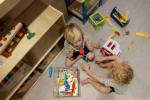Springs Preserve to host breastfeeding resource fair Aug. 9
August is National Breastfeeding Month, and Naturally Nurturing, a breastfeeding community fair, is scheduled from 10 a.m. to 2 p.m. Aug. 9 at the Springs Preserve, 333 S. Valley View Blvd., during World Breastfeeding Week. The free family event is set to include information booths, refreshments, infant massage, Gymboree play time, face painting, giveaways and more.
Admission to the event is free (mention it at the ticket window). It does not include general admission to the Springs Preserve, and museum and gallery admission are separate. Last year, the first year that Naturally Nurturing was held, saw about 100 attendees.
Breastfeeding has been called Mom’s special gift.
“It’s something a mom can give to her infant, that only she can do,” said Madeleine Sigman-Grant, Ph.D., a registered dietitian and president of the Southern Nevada Breastfeeding Coalition. “The ingredients in breast milk are unique and cannot be replicated in a can of formula. The only things we’ve been able to replicate are the nutrients, but there is so much more — immune properties, growth factors, things that affect the brain, the GI (gastrointestinal) tract — we can’t put that blend into a can.”
She said nursing provides a time for a mother to bond with her baby, especially in today’s hectic world when women often return to work. Sigman-Grant said the rates for breastfeeding in Nevada show that more than 80 percent of women want to breastfeed, at least part of the time.
The view of breastfeeding has been changing, she said.
“In the beginning it was, like, that’s disgusting. … Now, we’re recognizing that it is the natural thing to do,” Sigman-Grant said, adding that generations of formula-raised infants would likely show that they fall short in terms of health, intelligence and capabilities.
According to the Centers for Disease Control and Prevention, breastfeeding rates continue to rise. Breastfeeding initiation increased from 74.6 percent in 2008 births to 76.9 percent in 2009 births. This improvement in initiation represents the largest annual increase over the previous decade. Breastfeeding at 6 months increased from 44.3 percent to 47.2 percent.
Christine Fergus, childbirth educator for Summerlin Hospital Medical Center, 657 N. Town Center Drive, said the majority of women giving birth there elect to breastfeed and can attend classes, which average 15 couples. They are held twice a month, one in the afternoon and one in the evening.
Attendees learn feeding cues — the baby moving his lips while sleeping, sucking on his fist and bobbing his head up and down. Crying is a late sign of hunger. They’re taught to expect the infant to nurse eight to 12 times in each 24-hour period and the most common ways to hold a child for breastfeeding, which are the cradle hold, the football hold and lying down.
“I think most women understand that it is the best milk for the baby, that it’s the natural food for humans,” Fergus said. “They know there are a lot of immunity factors, but I don’t think most know that it’s disease prevention, not just helping when the child is a baby. It helps reduce diseases later on like heart disease and diabetes and obesity, even as an adult.”
Breastfeeding also has benefits for the mother.
“It helps them reduce the risk for type 2 diabetes and those metabolic type of diseases,” Fergus said. “It burns those calories, that weight we put on during pregnancy. It burns about 500 calories a day. So, it helps our metabolism, too.”
There are still social barriers and economic constraints, even though Nevada was one of the first states to enact a law, Nevada Revised Statutes 201-232, protecting a mother’s right to breastfeed in public.
“When a baby is hungry, a baby is hungry,” Sigman-Grant said. “A woman should not have to hide something that is natural. She shouldn’t have to go out to her car to breastfeed when it’s 105 degrees outside. Nor should she have to go to the ladies’ room to feed her baby. After all, how would you like it if your lunch was (served) in a bathroom?”
Sigman-Grant said in a perfect world, businesses, restaurants and community sites would have a private area set aside just for breastfeeding.
Fergus noted that besides the hassles of pumping milk at work, it’s “not as pleasant as when you’re holding your baby. Pumping is not the same and it also doesn’t empty the breast as well as a baby does.”
That means the milk supply drops and mothers have to supplement baby formula with their milk.
“Sometimes, they just give up,” Fergus said. “It takes real dedication to continue pumping. The recommendation is at least a year.”
Obstacles to breastfeeding can occur in the home as well, when fathers and grandparents insist they be allowed to feed the baby. There are other ways they can bond with the infant, said Sigman-Grant, such as giving the baby a massage or a bath, taking him for a walk or singing to him.
“It’s Mom’s milk that will get that baby to strive, to grow, to be protective,” Sigman-Grant said.
In 10 years, she said she’d like to see breastfeeding be the norm, with mother’s milk fed exclusively to infants for at least the first three or four months of life.
For breastfeeding assistance, visit nevadabreastfeeding.org or call 702-257-5583.
For more information about the event, visit snvbreastfeeding.org or call the Springs Preserve at 702-822-7700.
Contact Summerlin Area View reporter Jan Hogan at jhogan@viewnews.com or 702-387-2949.























